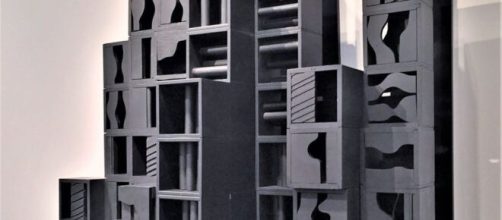If there’s an artwork that can cut across a world as messed up as ours, Louise Nevelson’s sculpture can. The big factor in her work that gets us where we need to be is the sense of quiet and order. (More about that in a moment).
First, a shout out to the Bank of America for funding the restoration of Nevelson’s "Shadow Chord" held at the Boca Raton Museum of Art in Florida. The repairs were part of the bank’s goal to conserve culturally significant art.
Stacking the deck
Granted, Nevelson didn’t embrace any of the art movements of the 20th century.
But she was key in moving the medium away from modeling and carving. In her case, she stacked discarded objects that she found in the streets of New York.
Not unexpectedly, critics didn’t like the change. Carlyle Burrows, art reviewer for the New York Herald Tribune would only allow that her sculptor was “well off the beaten track.” On her own track, Nelson became one of 20th-century America’s most celebrated sculptors.
How celebrated? The U.S. Postal Service issued a series of commemorative stamps detailing her larger works: “Silent Music I,” “Royal Tide I.” “Black Chord,” “Nightsphere-Light,” and “Dawn’s Wedding Chapel I.”
Now, about that sense of quiet and order in her work, it’s neither incidental nor accidental.
She rejected metal as a material because she said it was too noisy to work with, preferring instead what she called the “livingness” of wood that she found in scrap milk cartons, lettuce crates, balustrades and chair legs.
In order to disguise their former identity, she painted them in monochrome, mostly in black. And while such an absence of color can infer darkness and even death, she saw black as a sum of all colors.
“Shadow Chord,” then, alludes to the musical chord made of more than one note.
One might think that a pile of tossed milk cartons and lettuce crates, even if painted in one color, would be too self-evident, too bald and that stacking them would create too much rule.
In the shadows
But the numerous fissures and gaps in these assemblages save them from legibility, and lend them mystery, and secrecy, and all things unknowable like skeletons in cupboards.
And that air of mystery can be seen in many more of Nevelson’s sculptures than “Shadow Chord.”
When Dylan Thomas saw Nevelson’s “Moon Garden Plus One” – a stack of 116 varying size boxes – he said he felt a “seizure of silence” that left him breathless. And Dore Ashton raved in the New York Times that Nevelson’s work “saturated a room with idiosyncratic poetry.”
But poetry aside, it was the aura of order that Nevelson fixated on to escape what she called “the terribleness of existence.” Her biographer, Laurie Lisle noted that need in the 2001 book “Louise Nevelson: A Passionate Life.”
Lisle said the stability that Nevelson got from stacking geometric structures freed her and allowed her impulses to roam free.
In her own words, she made plain how essential order was to artmaking. "Art is a way to hold back the chaotic..."
“You can make the greatest work of art, and if it is not in your time, who cares? It’s not even valid…the artist is a mirror of his time.” And as far as Nevelson was concerned, the times are an untidy heap of lettuce crates that need straightening out.
Nevelson died in 1988. The untidy heap has grown still higher today.
.


